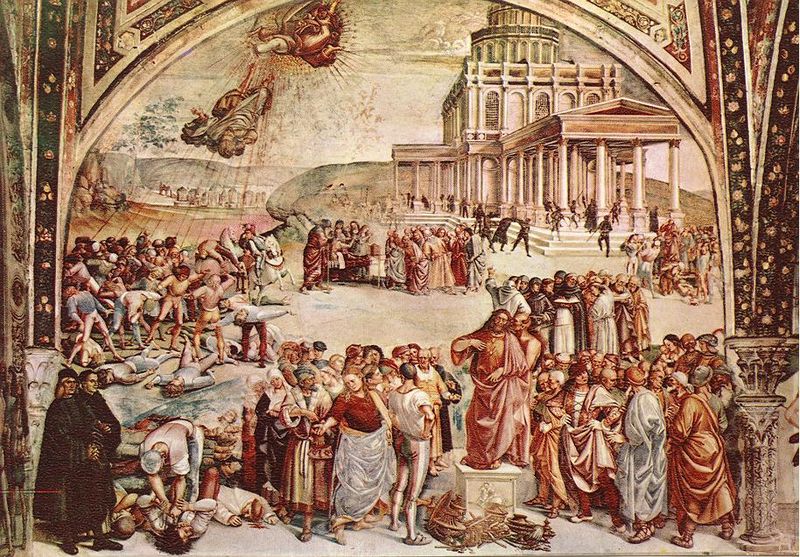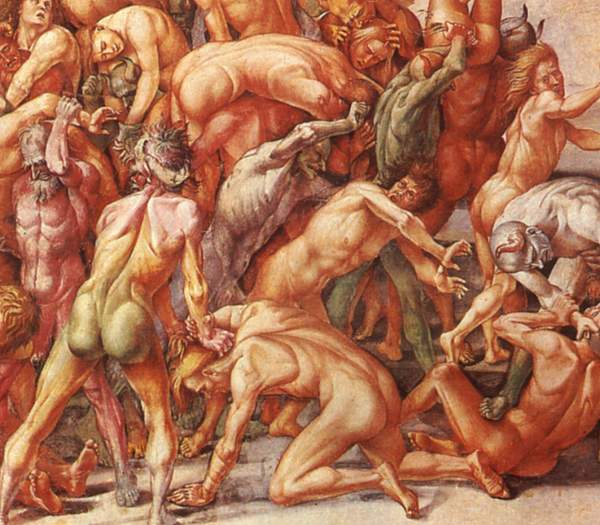Luca Signorelli (1445 – 1523)
Get a Signorelli Certificate of Authenticity for your painting (COA) for your Signorelli drawing.
For all your Signorelli artworks you need a Certificate of Authenticity (COA) in order to sell, to insure or to donate for a tax deduction.
Getting a Signorelli Certificate of Authenticity (COA) is easy. Just send us photos and dimensions and tell us what you know about the origin or history of your Signorelli painting or drawing.
If you want to sell your Signorelli painting or drawing use our selling services. We offer Signorelli selling help, selling advice, private treaty sales and full brokerage.
We have been authenticating Signorelli and issuing certificates of authenticity since 2002. We are recognized Signorelli experts and Signorelli certified appraisers. We issue COAs and appraisals for all Signorelli artworks.
Our Signorelli paintings and drawings authentications are accepted and respected worldwide.
Each COA is backed by in-depth research and analysis authentication reports.
The Signorelli certificates of authenticity we issue are based on solid, reliable and fully referenced art investigations, authentication research, analytical work and forensic studies.
We are available to examine your Signorelli painting or drawing anywhere in the world.
You will generally receive your certificates of authenticity and authentication report within two weeks. Some complicated cases with difficult to research Signorelli paintings or drawings take longer.
Our clients include Signorelli collectors, investors, tax authorities, insurance adjusters, appraisers, valuers, auctioneers, Federal agencies and many law firms.
We perform Luca Signorelli art authentication, appraisal, certificates of authenticity (COA), analysis, research, scientific tests, full art authentications. We will help you sell your Luca Signorelli or we will sell it for you.

Luca Signorelli was a Italian Renaissance painter. He was noted in particular for his ability as a draughtsman and his use of foreshortening. His massive frescoes of the Last Judgment (1499-1503) in Orvieto Cathedral are considered his masterpiece.

He was born Luca d’Egidio di Ventura in Cortona, Tuscany (some sources call him Luca da Cortona). The precise date of his birth is uncertain; birth dates of 1441-1445 are proposed. He died and in 1523 in Cortona, where he is buried. He was perhaps at the eighty-two years old. He is considered to be part of the Tuscan school, although he also worked extensively in Umbria and Rome.

His first impressions of art seem to be due to Perugia — the style of Bonfigli, Fiorenzo and Pinturicchio. Lazzaro Vasari, the great-grandfather of art historian Giorgio Vasari, was brother to Luca’s mother; he got Luca apprenticed to Piero de Franceschi. In 1472 the young man was painting at Arezzo, and in 1474 at Città di Castello. He presented to Lorenzo de Medici a picture which is probably the one named the School of Pan, discovered in Florence and formerly in Berlin (destroyed during the Second World War); it is almost the same subject which he painted also on the wall of the Petrucci palace in Siena — the principal figures being Pan himself, Olympus, Echo, a man reclining on the ground and two listening shepherds.

He executed, moreover, various sacred pictures, showing a study of Botticelli and Lippo Lippi. Pope Sixtus IV commissioned Signorelli to paint some frescoes, now mostly very dim, in the shrine of Loreto — Angels, Doctors of the Church, Evangelists, Apostles, the Incredulity of Thomas and the Conversion of St Paul. He also executed a single fresco in the Sistine Chapel in Rome, the Acts of Moses; another, Moses and Zipporah, which has been usually ascribed to Signorelli, is now recognized as the work of Perugino.

Signorelli worked in Rome from 1478-1484. He assisted in the decoration of the lower walls of the Sistine Chapel. The Testament of Moses is almost entirely of his hand. In the latter year he returned to his native Cortona, which remained from this time his home. In the Monastery of Monte Oliveto Maggiore (Siena) he painted eight frescoes, forming part of a vast series of the life of St. Benedict; they are at present much injured. In the palace of Pandolfo Petrucci he worked upon various classic or mythological subjects, including the School of Pan already mentioned.

From Siena, Signorelli went to Orvieto, and produced his masterpiece. These are the frescoes in the chapel of S. Brizio, in the cathedral, which already contained images in the vaulting over the altar by Fra Angelico, who had begun the murals fifty years earlier. The works of Signorelli represent the events surrounding the Apocalypse and the Last Judgment. The events of the Apocalypse, which reflect the scripture readings for the four Sundays during Advent, fill the space which surrounds the entrance into the large chapel. The events begin with the Preaching of Antichrist, and proceed to the Doomsday and The Resurrection of the Flesh. They occupy three vast lunettes, each of them a single continuous narrative composition. In one of them, Antichrist, after his portents and impious glories, falls headlong from the sky, crashing down into an innumerable crowd of men and women. The events of the Last Judgment, which reflect the scripture, read at the Feast of All Saints. These paintings fill the vaults and the space around the altar. Paradise, the Elect and the Condemned, Hell, the Resurrection of the Dead, and the Destruction of the Reprobate fill the lunettes surrounding the altar. To Angelico’s ceiling, which contained the Judging Christ and the Prophets led by John the Baptist, Signorelli added the Madonna leading the Apostles, Patriarchs, Doctors of the Church, Martyrs, and Virgins. There is also a great deal of subsidiary work connected with Dante, and with the poets and legends of antiquity. Other murals in the chapel depict an explicit reference to two important Orvietan martyrs in the centuries preceding the execution of the lunette paintings.

The daring and terrible inventions, with their powerful treatment of the nude and arduous foreshortenings, were striking in its day. Michelangelo is claimed to have borrowed, in his own fresco at the Sistine Chapel wall, some of Signorelli’s figures or combinations. The contract for his work is still on record. He undertook on April 5, 1499 to complete the ceiling for 200 ducats, and to paint the walls for 600, along with lodging, and in every month two measures of wine and two quarters of corn. The contract directed Signorelli to consult the Masters of the Sacred Page for theological matters. This is the first such recorded instance of an artist receiving theological advice, although art historians believe the two groups routinely discussed such matters. Signorelli’s first stay in Orvieto lasted not more than two years. In 1502 he returned to Cortona, and painted a dead Christ, with the Marys and the martyrs Saints Parenzo and Faustino.

After finishing the frecoes at Orvieto, Signorelli was much in Siena. In 1507 he executed a great altarpiece for S. Medardo at Arcevia in the Marche, the Madonna and Child, with the Massacre of the Innocents and other episodes.

In 1508 Pope Julius II determined to readorn the camere of the Vatican Palace, and he summoned to Rome Signorelli, in company with Perugino, Pinturicchio and Il Sodoma. They began operations, but were shortly all superseded to make way for Raphael, and their work was taken down. Luca returned to Siena, living afterwards for the most part in Cortona. He continued constantly at work, but the performances of his closing years were not of special mark.

In 1520 he went with one of his pictures to Arezzo. He was partially paralyzed when he began a fresco of the Baptism of Christ in the chapel of Cardinal Passerini’s palace near Cortona, which (or else a Coronation of the Virgin at Foiano) is the last picture of his specified. Signorelli stood in great repute as a citizen. He entered the magistracy of Cortona as early as 1488, and held a leading position by 1524 when he died.
Signorelli paid great attention to anatomy, carrying on his studies in burial grounds. He surpassed contemporaries in showing-the structure and mechanism of the nude in immediate action; and he even went beyond nature in experiments of this kind, trying hypothetical attitudes and combinations. His drawings in the Louvre demonstrate this and bear a close analogy to the method of Michelangelo. He aimed at powerful truth rather than nobility of form; color was comparatively neglected, and his chiaroscuro exhibits sharp oppositions of lights and shadows. He had a vast influence over the painters of his own and of succeeding times, but had no pupils or assistants of high mark; one of them was a nephew named Francesco.

He is described as kindly, a family man, according to Vasari, he always lived more like a nobleman than a painter. The Torrigiani Gallery in Florence contains a grand life-sized portrait by Signorelli of a man in a red cap and vest, and corresponds with Vasari’s observation. In the National Gallery, London, are the Circumcision of Jesus and three other works. Signorelli also depicted himself in the left foreground of his Orvietan mural The Rule of Antichrist. Fra Angelico, his predecessor in the Orvieto cycle, is thought to stand behind him in the piece.
Signorelli paid great attention to anatomy, carrying on his studies in burial grounds. He surpassed contemporaries in showing-the structure and mechanism of the nude in immediate action; and he even went beyond nature in experiments of this kind, trying hypothetical attitudes and combinations. His drawings in the Louvre demonstrate this and bear a close analogy to the method of Michelangelo. He aimed at powerful truth rather than nobility of form; color was comparatively neglected, and his chiaroscuro exhibits sharp oppositions of lights and shadows. He had a vast influence over the painters of his own and of succeeding times, but had no pupils or assistants of high mark; one of them was a nephew named Francesco.
Major works
• The Scourging of Christ (c. 1480) – Tempera on roundheaded panel, 84 x 57 cm, Pinacoteca di Brera, Milan
• Moses’s Testament and Death (1481-1482) – Fresco, 350 x 572 cm, Sistine Chapel, Vatican
• Madonna and Child with Saints (1484) – Panel, 221 x 189 cm, Museo dell’Opera del Duomo, Perugia
• Martyrdom of St. Sebastian – Pinacoteca of Città di Castello, Italy
• Madonna and Child (c. 1490) – Panel, 170 x 117,5 cm, Galleria degli Uffizi, Florence
• The Circumcision (c. 1490-91)
• Madonna and Child with St Joseph and Another Saint (1490-1492) – Panel, diameter: 99 cm, Galleria Palatina, Palazzo Pitti, Florence
• The Adoration of the Shepherds (1496) – Painted for the church of San Francesco, Città di Castello
• Lamentation over the Dead Christ (1502) – Wood, 270 x 240 cm, Museo Diocesano, Cortona
• Self-Portrait with Vitelozzo Vitelli (1500-1503) – Panel, Museo dell’Opera del Duomo, Orvieto
• Mary Magdalene (1504) – Panel, Museo dell’Opera del Duomo, Orvieto
• Calvary (1505)
• The Coronation of the Virgin (1508) – painted for the Filippini Chapel in the church of San Francesco, Arcevia
• The Trinity, the Virgin and Two Saints (1510) – Tempera on wood, 272 x 180 cm,
Galleria degli Uffizi, Florence
• Communion of the Apostles (1512) – Panel, 232 x 220 cm, Museo Diocesano, Cortona
• Virgin and Child with Saints (1515) – Painted for church of San Francesco, Montone, now in the National Gallery, London
• Immaculate Conception (c. 1523) – Panel, 217 x 210 cm, Museo Diocesano, Cortona
• Madonna and Child with Saints – Panel, Museo Nazionale di Castel Sant’Angelo, Rome
Still wondering about an Italian painting in your family collection? Contact us…it could be by Luca Signorelli.
Reviews
1,217 global ratings
5 Star
4 Star
3 Star
2 Star
1 Star
Your evaluation is very important to us. Thank you.
